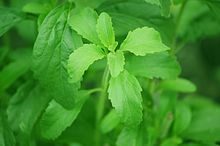Stevia
[12] The genus was named for the Spanish botanist and physician Pedro Jaime Esteve (Petrus James Stevus, 1500–1556) a professor of botany at the University of Valencia.[13] In 1899, Swiss botanist Moisés Santiago Bertoni, while conducting research in eastern Paraguay, first described the plant and the sweet taste in detail.[19][6]: 60 In December 2008, the FDA gave a "no objection" approval for GRAS status to Truvia[a] and PureVia,[b] both of which use rebaudioside A derived from the Stevia rebaudiana plant.[27][28] In May 2008, Coca-Cola and Cargill announced the availability of Truvia, a consumer-brand Stevia sweetener containing erythritol and Rebiana,[29] which the FDA permitted as a food additive in December 2008.[45] A 2010 review found that the use of Stevia rebaudiana sweeteners as replacements for sugar might benefit children, people with diabetes, and those wishing to lower their intake of calories.[46] Although both steviol and rebaudioside A have been found to be mutagenic in laboratory in vitro testing,[47] these effects have not been demonstrated for the doses and routes of administration to which humans are exposed.[51][52] The WHO's Joint Experts Committee on Food Additives has approved, based on long-term studies, an acceptable daily intake of steviol glycoside of up to 4 mg/kg of body mass.[47] In August 2019, the US FDA placed an import alert on Stevia leaves and crude extracts – which do not have GRAS status – and on foods or dietary supplements containing them due to concerns about safety and potential for toxicity.
Stevia (disambiguation)sugar substitutesweeterextractedStevia rebaudianaParaguayBrazilsteviol glycosidessteviosiderebaudiosidefermentableglycosidescaloriesaftertastelicoricebitterfood additivedietary supplementUnited Statesgenerally recognized as safeFood and Drug AdministrationEuropean UnionGuaraní peoplesPedro Jaime EsteveUniversity of ValenciaMoisés Santiago BertoniDietary Supplement Health and Education Act of 1994European CommissionWorld Health OrganizationTruviaPureViarebaudioside AU.S. Customs and Border Protectionprison laboraqueousextractMorita Kagaku Kogyonatural foodshealth foodNutraSweetthe Coca-Cola CompanyRebianaCargillerythritolCoca-Cola LifePepsiCobitternessextractioncrystallizationethanolmethanolsolventSteviolsweet glycosidesaglyconespolysaccharidestaste receptorsbasic researchprotein channelsynergeticproteinsdiabetesmutageniccontraceptivecontrol groupacceptable daily intakeEuropean Food Safety AuthorityMemorial Sloan Kettering Cancer CenterCenter for Science in the Public InteresttoxicityThaumatinMiraculinMogrosidemonkfruitbrand-nameCoca-Cola CompanyWhole Earth Sweetener CompanyMerisantBertoni, Moisés SantiagoThe New York TimesVegetarian TimesReutersBibcodePhytochemistryScienceAngelicaBay leafIndian bay leaf (tejpat)BorageChervilChivesgarlic / ChineseCicelyCoriander leaf / CilantroBolivianVietnamese (rau răm)CulantroCurry leafEpazoteHoja santaHouttuynia cordata (giấp cá)HyssopKinh gioi (Vietnamese balm)KkaennipLavenderLemon balmLemon grassLemon myrtleLemon verbenaLimnophila aromatica (rice-paddy herb)LovageMarjoramMugwortMitsubaOreganoParsleyPerillaRosemarySavorySanshō leafSorrelTarragonWoodruffSpicesAonoriAjwain
